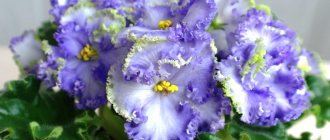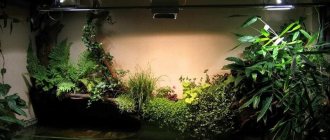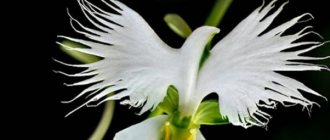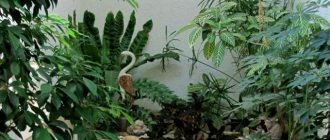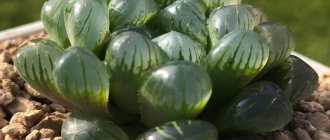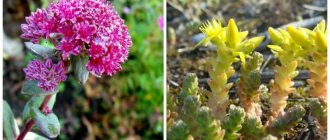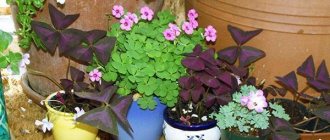Lighting needs of plants
Most indoor flowers need good lighting to grow and turn green. Therefore, owners of apartments with windows facing north or east find it difficult to choose indoor green residents that will grow and bloom well even in the shade.
Look at the photos and names of indoor seedlings that will grow in the most shaded corner of the house and not suffer from lack of sun.
These shade-loving plants are suitable not only for home cultivation, but also for decorating shaded terraces and balconies. Among them there are ampelous, flowering and deciduous beautiful specimens.
Most shade-loving plants tolerate a lack of light and grow even better in the dark or in places with diffused light. Shade-tolerant plants can be grown on a “northern” windowsill or at a distance from a lighted window.
Shade-tolerant flowers grow a little slower, but never lose their chic appearance.
If it seems that there is light in the apartment, the light intensity here is still insufficient. Illumination does not remain constant even in the brightest room; it changes throughout the day. Often the level of illumination depends on obstacles in the form of trees and nearby buildings blocking sunlight.
The illumination of the rooms also depends on the seasons and the location of the windows:
- Sunlight pours into the apartment almost all day through the southern windows.
- Windows that “look” to the east most often catch sunlight only in the mornings.
- Western windows receive more light in the late afternoon.
- Windows facing north receive almost no direct light, but they can have indirect light throughout the day.
Shade-loving indoor vegetation will feel good both on the northern window and in the back of the room.
With the help of shelves, vertical supports, hanging flowerpots, you can decorate any interior with shade-tolerant varieties.
Selaginella
You may be interested in: Names of indoor flowering plants: description of the appearance of flowers and photos What types of indoor palm trees exist and how to grow a flower at home Growing indoor milkweed, methods of propagation and general description
Looking at this green pillow, you first think that you are near a surface of water covered with algae. In fact, it is a ground-blooded perennial with small, needle-like, moss-like green leaves.
Selaginella comes from South America, where it thrives under the shade of large trees.
The plant reproduces, like most ferns, by spores, but the arrangement of its needles is similar to that of a coniferous plant. Scientists still attribute Selaginella to one species or another.
In addition to spores, the plant forms roots and a tuber on its steps, which take root very well, and it is these that gardeners separate to obtain new shoots.
Blooming shade-tolerant houseplants
Many residents of city apartments want to breed only flowering varieties of green pets. Beautiful buds decorate the room, lift your spirits and provide wonderful moments of relaxation after a hectic day at work.
Begonia
The most favorite flower is the unpretentious beauty begonia. Even partial shade will not prevent it from blooming lushly. If a shade-loving begonia is placed in bright sun, its colors will begin to fade and the plant will lose its attractiveness.
When exposed to light, the bright green carved leaves of the beauty will begin to fade and become smaller, and soon the entire bush will become inconspicuous.
In indoor plant growing, the following unpretentious varieties of begonias have become the most popular:
- "Rex"
- "Drege"
- "Odorata"
- "Mason".
Violet
It is difficult to find a more popular flower than the Usambara violet. It blooms almost all year round with beautiful colorful bouquets. This is the best flowering perennial for the home.
Pots take up little space, so they can occupy any free corner with soft, diffused lighting. The western and eastern windowsill for shade-loving Saintpaulia is the best place for development and flowering. And under the burning rays of the sun, she can die from burns.
Anthurium
Anthurium is valued for its spectacular flowers that will decorate a darkened corner of the apartment for several weeks. This plant prefers diffused light, warmth and good care.
Anthurium will do well in summer at an air temperature of 23°C, and in winter 17°C. This capricious, shade-loving culture does not tolerate bright sunlight at all.
Clivia
Clivia is a luxurious exotic plant that blooms 2 times a year (in early spring and late autumn) and can decorate the shady side of an apartment.
The house plant is notable for the fact that during flowering it produces succulent flower stalks to a height of 27 centimeters. In this case, a large number of bright buds can form on the peduncle: from 12 to 25 pieces.
To see a flower in all its splendor, it is necessary to create conditions: warmth, regular watering, soft diffused light. Light shading of clivia is also not dangerous. The direct rays of the hot sun are more dangerous; they burn the beautiful leaves of the shade-loving flower crop.
Cyclamen
Unpretentious cyclamen will bloom even in light partial shade, but in the sun it will be very bad.
Cyclamen is loved for its spectacular blooms with large flowers that look like butterflies or bells. The color of the flowers can be white-pink, dark burgundy, and often purple-violet.
Popular varieties of cyclamen:
- Kossky,
- Persian,
- Cypriot.
Fuchsia
Fuchsia is a magnificent flowering perennial prized for its long-lasting blooms. It can grow well in light, partial shade and shade. The color of the buds can be creamy-pink, lilac-violet and red. Two-color large fuchsias are very popular.
Dicentra
It is a popular garden plant but often grows in the home greenhouse. Grows best in shade and partial shade. The height of the home shade-loving dicentra is 30-50 centimeters. It can bloom for several months, producing small heart-shaped flowers.
The color of the hearts varies from white-pink to purple-pink.
Calathea Crocata
This unpretentious crop produces beautiful flower stalks with yellow lights above dark green foliage. Loves warmth and spraying, but is afraid of drafts.
Fittonia
The next plant, which belongs to non-blooming indoor flowers, differs in its shades from decorative deciduous ones. Its name is Fittonia. In the photo it shimmers with all the colors. At first glance, this small plant is somewhat reminiscent of coleus, although the leaves are somewhat different, more rounded, without an acute angle. But, like coleus, the color is varied, including shades of pink and purple.
Advice!
The bright foliage of Fittonia needs constant lighting during the daytime, otherwise it will lose its color and may simply turn into a green plant. The best location is in the west and east.
When watering Fittonia, you should remember that it evaporates a lot of water, the lump dries out in about 2 days in the summer and needs another portion of liquid.
Decorative deciduous shade-tolerant plants
In order not to leave the dark corners of the house without greenery, you need to choose the most shade-loving indoor plants and decorate the interior. It’s good that among the plants you can choose those that can turn green even in low light without losing their beauty and attractiveness.
They may not bloom in lush bouquets, but they can boast of the beauty of their foliage with different shades of green.
Chlorophytum
If you want to decorate the deepest parts of the room, then choose deciduous varieties. It should be borne in mind that even the most shade-loving indoor plants can only be distanced 2 meters from northern windows and 3 meters from windows located in other parts of the world.
Shade-loving chlorophytum is suitable for landscaping the depths of rooms and offices. Today, so many varieties of this modest plant have been grown that even flowering specimens pale in comparison to its beauty.
Aspidistra
Aspidistra is tall, striking in the beauty of its leaves covered with white powder. But if you want to grow aspidistra in a dark corner, then it is better to choose bushes with a pure green color, otherwise the white haze will disappear.
This plant may have inconspicuous flowers under the leaves, but they do not play a role. The flower is decorated with large succulent leaves.
This is one of the more shade-tolerant houseplants and can be placed in a very dark location. Another advantage of aspidistra is its amazing unpretentiousness. True, in winter the plant will need to reduce the temperature to 12-15 degrees.
Aglaonema
Aglaonema can have leaves of different shapes and colors. Reaching a height of 30-60 cm, the plant forms a beautiful bush, where the stems are not visible at all behind the foliage.
Thanks to its shades of silver and green, the plant always looks very elegant, even in the darkest corner of the room. With very good care it can please you with flowers.
Alocasia
Alocasia captivates with the beauty of its very large leaves. The spectacular beauty attracts attention with the veins of cream-colored foliage arranged on the plate in the form of a mosaic. Can grow from 50 cm to 2 meters.
Capricious alocasia is not demanding in terms of lighting, but is picky about care. You can't reduce humidity, but you can't increase it either. The same requirements apply to temperature and watering.
Soleirolia
Soleirolia is a creeping plant adapted to grow at home. In nature, soleirolia grows, as a rule, in the darkest places, on rocks, in the seams between stones. As a result, curly greenery will decorate any interior.
Multi-row sickle-shaped
The multi-row sickle-shaped plant feels good at a distance of 2-3 meters from the window. Reaching a height of 50-70 cm, the multi-row plant produces very beautiful glossy openwork leaves.
The main disadvantage of a multi-row plant is its love for cool temperatures: about 10 degrees in winter, and 16-18 degrees in summer. If you keep the soil moist and spray frequently, the multi-row plant can adapt to higher temperatures.
Pilea
The plant is from the nettle family, but in some species you can’t tell, that is, there are infrequent fibers on the leaves. The leaf blades themselves can be, like nettles, heart-shaped, pointed in shape, but also round or oval. Some resemble violets at first glance.
There are green and bicolor ones, when there are white stripes along the entire leaf, bordered by an emerald hoop. Certain varieties have leathery foliage.
Ampelous plants
Ampelous plants can enliven any corner of the house. They hang so beautifully from the walls of pots or wrap around supports that even non-blooming specimens look fresh and impressive.
Indoor grapes
Tetrastigma Voignier, or indoor grape, is one of the top shade-loving vines.
The fast-growing climbing vine has become famous for its juicy, large leaves with a jagged edge. The height of the plant can reach 4 m. The climbing perennial beautifully decorates not only shady walls, but also any vertical support. Suitable for decorating a living screen.
Unpretentious, almost does not react to low air humidity, but loves fresh air. Easily tolerates pruning.
Ivy
Hedera or ivy is an elegant decorative indoor flower with spectacular carved foliage. Loves shaded places and does not tolerate bright lighting. In the sun, the leaves of the hedera fade and lose their beautiful emerald color.
Epipremnum
Epipremnum is a green vine used to decorate walls in the shade. It grows very quickly, occupying the entire wall with climbing vines up to 6 meters long.
The shade-loving houseplant can take root in any conditions and requires almost no attention. Watering and fertilizing are all the flower's requirements.
Tetrastigma
Tetrastigma is one of the spectacular climbing plants. You can decorate any room, even a gazebo built among the trees in the garden.
In indoor floriculture, ampelous varieties such as Tetrastigma lanceolata and Voignier have become popular. These vines do not care what kind of light there is in the room. They turn green beautifully in low light. In bright light, their emerald greens, on the contrary, turn very pale.
Tradescantia
Tradescantia is an evergreen climbing perennial with long shoots covered with small leaves. The varieties of this crop amaze the imagination with the colors of their foliage, from emerald, variegated, tricolor, to purple.
With good care and growing in favorable conditions, it can please you with very beautiful flowers.
Tradescantia is one of the most popular hanging plants. It requires almost no maintenance, and the resulting curly stems will quickly decorate any home greenhouse.
They tolerate shade well, even light drought. Under the hot rays of the sun, Tradescantia leaves, as a rule, fade and wither.
Unpretentious aquarium plants for beginners
Aquarium plants are a kind of exotic. But many of them need special care and attention. And there are also unpretentious specimens that easily adapt to both temperature conditions and other water parameters.
Elodea
Elodea canada is completely unpretentious to temperature and water hardness . Moreover, it is a useful plant characterized by active and intensive growth. It will bring special notes to the interior thanks to its unusually bright color.
Hornwort
This plant can be placed not only in an aquarium, but also in an ordinary three-liter jar. And it will grow, feeling great! True, the more space a culture gets, the more luxuriantly it will grow.
Cirrus
A completely unpretentious aquarium plant. Cirrus has been known for several centuries, and it has always been used to decorate artificial reservoirs. As this culture grows, it creates an attractive openwork pattern that looks beautiful through the glass walls of the aquarium.
Vallisneria
A hardy plant characterized by excellent survival rate in any conditions. It is not affected by water hardness or temperature. When kept in large containers, Vallisneria can grow to impressive sizes.
key moss
This decorative type of moss is now not used very often. But in vain, because it does not require maintenance, and it does not require changing the water in the aquarium too often. The only drawback can be considered its ordinary, discreet appearance.
Thai fern
The plant does not tolerate bright light, so it is recommended to place the aquarium with it in the shade. The culture is characterized by slow growth, but it is ideal for decorating an aquarium. In addition, the appearance of the Thai fern is very attractive; it will be a good decoration for any room.
Echinodorus Amazonis
Amazon is a culture that is not distinguished by its unusual appearance, but it is unpretentious in care . It is enough to provide the echinodorus with good lighting and stay in warm water. There are no further requirements for the conditions of its detention.
Palm and large-sized
People have always been attracted to large plants that can be grown at home. Any large flower is a real pride for its owner.
If space allows, then all owners of a home greenhouse try to acquire a large green pet.
Hamedorea
Hamedorea is an elegant palm tree. In a pot it can grow over a meter in height.
An amazingly beautiful palm tree with airy leaves, like the feathers of an exotic bird. In the wild it also grows in the shade and generally does not tolerate the bright rays of the sun.
Hamedorrhea is demanding to care for. Prefers warmth, frequent misting and turning the pot opposite sides to the light so that its luxurious leaves grow properly.
Aucuba japonica
Aucuba japonica from Japan moved to our flower growers. An amazing flower, the leaves of which are covered with golden droplets, rises to a height of 1.5 meters. For its golden design it was called the “golden tree”.
Aucuba is a poisonous plant, so care must be taken when pruning. With the help of pruning, the tree can be given any shape. Like all tree-like species, it lives for decades.
Loves dense shade, moderate watering and humidity. Does not respond to sudden temperature changes.
Ficus benjamina
Ficus benjamina - a luxurious two-meter exotic plant is often used in phytodesign. Loves space, soft diffused lighting and good care.
Sansevieria
Sansevieria is an unpretentious, attractive plant that is often found in home greenhouses. A flower with an original “marble” foliage color is suitable for both an apartment and an office.
It purifies the air of toxic substances that are released during the operation of various electronic equipment, while releasing oxygen. This process most often occurs in the dark or at night, so it can be placed in the bedroom.
Allocasia
A spectacular flower, with huge (up to 30 cm) leaves that have waves along the edge. The veins stand out well against the background of emerald foliage, as they have a light shade.
Allocasia is a relative of chokeberry, as it belongs to the araceae family. It has a very interesting feature: it can show its owner that he poured a lot of water when watering. When excess liquid forms in the pot, allocasia releases water droplets on the leaves.
Caring for allocasia is the same as for other plants of the humid tropics and subtropics growing under the canopy of trees.
Ferns
If you need to add greenery to a shaded corner of your apartment, you should put a fern on the shelf. A beautiful green bush hanging down will decorate any interior.
Ferns in nature grow in the shade of tall trees, so low light for them is not an obstacle to the lush growth of carved greenery. It is recommended to place pots with ferns on the western, eastern or northern side of the house. These indoor flowers have several types.
One of the most decorative ferns is considered to be the adiantum with delicate, lush green leaves.
Ferns are planted in a tight container and watered abundantly. The best watering is to place the flowerpot in a basin of settled water, and then allow the excess moisture to drain.
Loves spraying, good ventilation and shaded areas. Sunburn can kill you.
Antler
Among non-blooming indoor flowers, this plant has several names: flathorn, platicerium. This is a small but impressive plant that will have its advantages in macro photography. Under natural conditions it lives on trees, that is, it is an epiphyte.
- Foliage. The plant belongs to ferns, so its leaves are dissected, but, unlike others, not completely, but only by a third, resembling a deer antler, which owes its name. There are two types - regular and spore-bearing. Ordinary ones do not overwinter, but turn brown. They are not subject to pruning, as they provide food for the root system.
- Stem. Shortened, it is actually on the surface and goes straight into the root system.
A special feature of care is that although the plant is moisture-loving, you should not spray it on the plates when spraying, this can lead to problems. It is better to increase the air humidity by spraying liquid around or placing the pot on expanded clay.
Conifers
Small thujas, evergreen coniferous trees, have become widespread in indoor floriculture. The beneficial advantages of thuja are known: endurance, unpretentiousness, beautiful appearance, and the ability to purify the air of toxins.
Thujas do not need bright light. And the sun's rays seem to burn out the emerald color of the tree, depriving it of its attractiveness.
Caring for shade-loving plants
Shade-loving and unpretentious crops also require care.
Caring for green pets:
- Place away from direct sunlight. Can be placed on shelves, cabinets, tables in corners.
- When planting in a pot, use fertile soil for indoor flowers. Do not feed for 3-4 months.
- Feed with complex fertilizers.
- You can clean it from dust in the shower.
- Protect from drafts.
- Water as the soil dries.
- Spray with a spray bottle, maintaining humidity.
Options for decorating an apartment using shade-loving plants
Using shade-tolerant houseplants when decorating apartments, you can conduct experiments, or you can take the advice of phytodesigners.
Techniques for decorating space by room
- Hallway: single tall ficuses, palm trees or group compositions in the form of a plant mosaic will look beautiful here.
- Kitchen: the “place of refuge” for most flowers is the windowsill. Here you can plant chlorophytum, violets, and sheflera. Cissus and Tradescantia will happily grow on cabinets. It is best to place the “Pike Tail” in a corner on the floor or near the radiator.
- The living room is an area of daring imagination and limitless experiments. A large room is the best place to create a green screen or a cascading composition, where a tall tree is placed in the corner, then medium-sized specimens, and a small large-leaved flower completes the group.
- The bedroom is not a place for a lot of flowers. A shelf is placed here, and small flowerpots with flowers are placed on it.
- Bathroom - there are many shelves here that are filled with small flowers. You can put the most moisture-loving specimen in the corner. Here you can use very small-sized flowers, which will need to be periodically exposed to sunlight. A small flower is easier to transfer to light, so they are suitable for decorating a bathroom.
Location of flowerpots
To change the interior of the room every time, try planting compositions of indoor flowers in flowerpots. A tall flowerpot looks beautiful next to flowers in small pots of the same color.
An original stand with flowerpots for the living room.
Flowerpots with flowers can be used to decorate a gazebo, the entrance to a house or a terrace.
Shade-loving indoor plants for the hallway
Most often, the hallway is left without green decoration due to constant darkness. But there are shade-loving indoor plants specifically for the hallway.
Flowers located in the space of a dark hallway give it a cozy and well-groomed look.
What plants are able to grow in conditions of low light?
The most unpretentious foliage and ornamental plants have foliage of unusual shape and color, so they will decorate the darkest corridor.
When decorating a hallway, you can’t do without evergreen sansevieria, which was given the funny name “mother-in-law’s tongue.”
Exotic shefflera does not require special development conditions. An elegant deciduous bush, up to 2 meters high, can be installed in the corner of the hallway.
Ferns of all kinds will also decorate a dark corridor.
Aglaonema - suitable for growing in low light areas. However, it does not tolerate dry air, so it should not be placed near heating radiators.
Palm trees and dracaena can also be placed in the hallway. In addition to deciduous specimens from the world of tropical flora, many flowering plants can turn green and develop in a dark corridor.
Spathiphyllum is an evergreen plant with glossy, rather large leaves and oblong snow-white flowers. This exotic is a real find for decorating dark corners of the apartment.
You can’t do without chlorophytum either. It will not only decorate the hallway, but also rid it of harmful substances that are emitted by the cabinets in this part of the house. The walls of the corridors will be decorated with graceful hedera and tradescantia vines.
Bonsai trees will fit organically into the space of dark corridors:
- carmona,
- barberry and
- pyricantha.
Cacti and succulents are another group of plants that can decorate a dimly lit hallway and other rooms.
